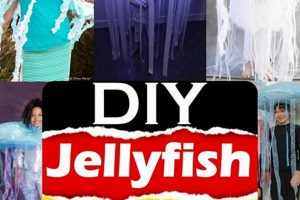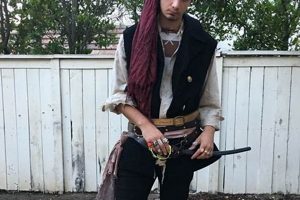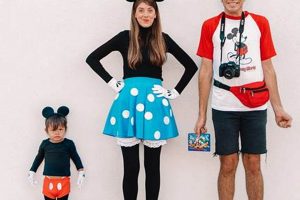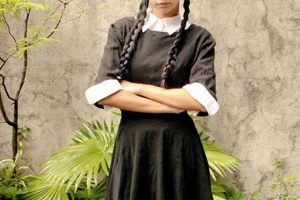The creation of a unique cryptid-inspired outfit, specifically one resembling the Mothman, often involves individual craftsmanship and resourcefulness. This approach utilizes readily available materials and personal skills to construct a recognizable and often personalized representation of the legendary creature.
Constructing such an outfit provides a creative outlet, allowing individuals to express their interest in folklore, mythology, and costume design. Furthermore, this process can be more economical than purchasing commercially produced costumes, and offers the satisfaction of a handcrafted item. The practice also connects individuals with a history of self-sufficiency in costume creation, predating mass-produced alternatives.
The subsequent sections will delve into specific material choices, construction techniques, and design considerations that are vital for developing an effective and compelling recreation of this iconic figure.
Construction Guidance
The following points provide guidance on the effective creation of a cryptid-inspired outfit resembling the Mothman. These tips emphasize material selection, construction methods, and design considerations.
Tip 1: Wing Framework Construction: Employ lightweight, durable materials such as PVC pipe or bamboo for the wing framework. This framework will support the fabric and allow for a defined wing shape. Ensure secure connections at all joints to maintain structural integrity during movement.
Tip 2: Fabric Selection for Wing Covering: Choose a dark-colored, lightweight fabric such as ripstop nylon or black broadcloth for covering the wing framework. The fabric should be durable enough to withstand outdoor use and capable of being stretched tautly over the frame. Secure the fabric to the frame using industrial adhesive or by sewing it directly onto the structure.
Tip 3: Headpiece Design and Implementation: The headpiece should incorporate large, prominent eyes. These can be constructed from translucent plastic or acrylic domes, painted with a reflective red finish to mimic the creature’s signature gaze. Secure the eyes to a comfortable and stable head mounting, such as a helmet or reinforced hood.
Tip 4: Garment Integration for Body Shape: Consider using a dark-colored jumpsuit or similar garment as the base for the body. This provides a foundation upon which to attach additional detailing, such as faux fur or feather-like textures, to create a more imposing and creature-like silhouette.
Tip 5: Footwear Modification for Enhanced Effect: Modify existing footwear to enhance the costume’s overall impact. This could involve attaching elongated soles or fabricating claw-like coverings to simulate the creature’s supposed avian or reptilian feet. Ensure that the modifications do not impede mobility or create a safety hazard.
Tip 6: Utilizing Color and Texture for Realism: Pay close attention to the color palette and textures employed. Dark, muted tones are generally preferred, with strategic use of contrasting colors for highlights and accents. Incorporating varied textures, such as faux fur, feathers, and scales, can further enhance the costume’s realism and visual appeal.
Tip 7: Prioritize Comfort and Mobility: While visual accuracy is important, comfort and mobility are paramount. The costume should allow for ease of movement and should not restrict breathing or vision. Conduct thorough testing to identify and address any potential issues before wearing the outfit for extended periods.
By adhering to these guidelines, individuals can increase the likelihood of producing a compelling and functional representation, suitable for costume events or theatrical performances.
The subsequent section will address common pitfalls to avoid when embarking on this ambitious creative endeavor.
1. Wing Span
Wing span, within the context of a handcrafted Mothman-inspired outfit, constitutes a primary visual element that directly impacts the costume’s overall presence and recognizability. Its scale and design significantly influence the audience’s perception of the creation.
- Dimensional Accuracy
The wing span must be proportionate to the intended body size of the costume. A disproportionately small span diminishes the creature’s imposing figure, while an excessively large span may render the costume unwieldy and impractical. Researching reported Mothman sightings or artistic interpretations can guide dimensional decisions. The selection of materials capable of sustaining the chosen wing span without excessive weight or fragility is crucial.
- Structural Integrity
The framework supporting the wing span necessitates careful engineering. Materials such as PVC pipe, lightweight metal, or reinforced plastics provide structural stability. Joints must be securely fastened to withstand stress during movement and potential wind resistance. Insufficient structural support will lead to sagging or collapse, detracting from the costume’s aesthetic and potentially posing a safety hazard.
- Fabric Surface Area
The wing span dictates the amount of fabric required to cover the wing structure. This choice of fabric typically dark-colored, lightweight materials like ripstop nylon or broadcloth must be carefully considered. The fabric must be durable and able to maintain its shape when stretched across the frame. Seams and attachment points must be reinforced to prevent tearing under stress.
- Mobility and Practicality
While a large wing span contributes to visual impact, the design must account for the wearer’s mobility. Overly expansive wings can hinder movement through doorways, public spaces, or crowded environments. A compromise between visual dominance and practical functionality is necessary. Articulated wings or foldable designs allow for controlled adjustments of the wing span as needed.
The careful consideration of dimensional accuracy, structural integrity, fabric surface area, and mobility, in relation to the wing span, forms a critical aspect of the successful creation of a Mothman-inspired outfit. These factors directly influence the visual impact, durability, and practicality of the completed garment.
2. Headpiece Design
The headpiece is arguably the most crucial element in the creation of a credible Mothman-inspired outfit. It serves as the focal point, immediately conveying the creature’s distinct characteristics and influencing overall recognition.
- Facial Structure Representation
Accurate representation of the Mothman’s purported facial features is paramount. This includes the shape and proportions of the head, the placement and size of the eyes, and any discernible beak or snout-like structure. Deviations from established descriptions or artistic interpretations can
significantly detract from the costume’s effectiveness. For example, an overly rounded head shape might unintentionally suggest a different creature, while improper eye placement can create a comical or unconvincing effect. Understanding the established folklore surrounding the Mothman’s appearance is therefore a necessary prerequisite. - Eye Construction and Illumination
The large, reflective eyes are the creature’s most iconic feature. The method of constructing and illuminating these eyes is critical to the headpiece’s success. Options range from using pre-made acrylic domes painted with reflective materials to crafting custom eyes from resin or plastic. Illumination can be achieved through various methods, including battery-powered LEDs, fiber optics, or even strategically placed reflectors that catch ambient light. Regardless of the chosen method, the eyes must be both visually striking and securely mounted to avoid becoming dislodged or obscured during wear. Color accuracy, typically a deep red or orange, is also essential for maintaining the creature’s characteristic appearance.
- Material Selection and Integration
The choice of materials for the headpiece directly impacts its weight, durability, and overall aesthetic. Lightweight materials such as foam, plastic, or papier-mch are often preferred to minimize strain on the wearer’s neck. The selected materials must also be compatible with the chosen construction techniques, such as gluing, sewing, or molding. Seamless integration with the rest of the costume is also important. For instance, the headpiece should blend smoothly with the neck and shoulder areas to create a cohesive and believable silhouette. Using similar textures and color palettes across the entire outfit enhances this effect.
- Wearability and Safety Considerations
Beyond visual accuracy, the headpiece must be comfortable and safe to wear for extended periods. Adequate ventilation is crucial to prevent overheating and fogging of the eye coverings. The headpiece should also fit securely without restricting movement or obstructing vision. Sharp edges or protruding components should be avoided to minimize the risk of injury. Before wearing the costume in public, it is advisable to conduct thorough testing to identify and address any potential comfort or safety issues. This may involve wearing the headpiece for extended periods, performing various movements, and simulating different environmental conditions.
In conclusion, effective headpiece design is pivotal for creating a compelling Mothman-inspired outfit. Careful consideration of facial structure, eye construction, material selection, and wearability is essential for achieving a visually striking and safe costume that accurately represents the legendary creature. Neglecting these aspects can result in a poorly executed costume that fails to capture the essence of the Mothman.
3. Material Choice
The selection of materials in crafting a do-it-yourself Mothman costume significantly influences the final product’s aesthetic appeal, durability, and practicality. Careful consideration of material properties is crucial for achieving a convincing and functional result.
- Fabric Selection for Wing Surfaces
The material chosen for the wing surfaces impacts both the visual appearance and structural integrity of the costume. Lightweight yet durable fabrics such as ripstop nylon or black broadcloth are commonly employed. Ripstop nylon offers tear resistance and a distinct texture, while broadcloth provides a smoother, more matte finish. The selection hinges on the desired aesthetic and performance characteristics. Cheaper fabrics may tear easily or lack the necessary drape, diminishing the overall effect.
- Framework Materials for Wing Support
The framework supporting the wings requires materials with sufficient strength-to-weight ratio to maintain their shape during wear. Options include PVC pipe, bamboo, or lightweight metal rods. PVC pipe offers affordability and ease of assembly, while bamboo provides a natural, flexible alternative. Metal rods offer superior strength but may add significant weight. Inadequate framework materials will result in sagging or unstable wings, compromising the costume’s silhouette.
- Headpiece Construction Materials
The headpiece material should be lightweight for wearer comfort and amenable to shaping and detailing. Foam, papier-mch, and thermoplastic materials are frequently used. Foam allows for easy sculpting and shaping, while papier-mch offers a cost-effective alternative. Thermoplastics, when heated, can be molded into complex shapes. A poorly chosen headpiece material can lead to discomfort, overheating, or an unrealistic appearance.
- Fastening and Attachment Components
Adhesives, fasteners, and connecting hardware play a critical role in securing the various costume components. Industrial-strength adhesives are necessary for bonding fabric to framework, while rivets, screws, or zip ties provide mechanical fastening. Substandard fastening materials can result in component separation and costume failure during use. The choice of fastening method should align with the selected materials and intended level of stress.
Ultimately, judicious material choice is paramount to the success of any do-it-yourself Mothman costume endeavor. Selecting materials based on their aesthetic properties, structural capabilities, and ease of use will contribute significantly to a visually impressive and enduring representation of the cryptid.
4. Silhouette Accuracy
Silhouette accuracy represents a critical design element in the creation of a homemade Mothman costume. The overall visual impact and recognizability of the costume hinge significantly on the accurate portrayal of the creature’s distinct outline and proportions. Discrepancies in silhouette can diminish the costume’s credibility and potentially render it unrecognizable to those familiar with the Mothman legend. The effect of an inaccurate silhouette is akin to viewing a distorted image; the essence of the subject is lost. Consequently, meticulous attention to detail in replicating the Mothman’s purported form is essential for a successful costume.
The achievement of silhouette accuracy necessitates careful consideration of several factors. These include the dimensions of the wings relative to the body, the shape and size of the headpiece, and the overall proportions of the costume. Real-life examples of successful Mothman costumes often demonstrate a keen understanding of these principles. For instance, costumes that effectively utilize elongated limbs and a downward-sloping wing profile closely mirror descriptions and artistic interpretations of the creature, resulting in a more convincing representation. Conversely, costumes with poorly proportioned wings or an overly bulky body often fail to capture the Mothman’s ethereal and unsettling presence. Accurate shoulder, neck and head proportion is a very important area to improve and analyze silhouette.
In summary, silhouette accuracy serves as a cornerstone of a compelling Mothman costume. Failure to prioritize this aspect can significantly detract from the costume’s visual impact and recognizability. Through careful planning, meticulous execution, and a thorough understanding of the creature’s purporte
d form, individuals can create costumes that effectively capture the essence of the Mothman legend. Addressing challenges in replicating the silhouette, such as achieving accurate proportions or maintaining structural integrity, is crucial for producing a successful and memorable costume.
5. Eye Luminosity
Eye luminosity serves as a defining characteristic in depictions of the Mothman, frequently highlighted in eyewitness accounts and artistic renderings. Within the context of creating a Mothman-inspired outfit, replicating this luminous quality presents a significant challenge and a crucial element in achieving a convincing representation.
- Light Source Selection
The choice of light source directly influences the intensity, color, and overall effect of the illuminated eyes. Options range from battery-powered LEDs to electroluminescent wire or even reflective materials that capture ambient light. LEDs offer a controllable and energy-efficient solution, while electroluminescent wire provides a consistent glow. Reflective materials, while passive, can create a striking effect under specific lighting conditions. The selection criteria should include brightness, battery life, color accuracy (typically red or orange), and ease of integration into the headpiece. Inadequate light source selection results in dim, uneven, or unrealistic eye luminosity.
- Lens Material and Diffusion
The material used to create the eye lens, and its diffusion properties, significantly impact the appearance of the emitted light. Clear acrylic domes, frosted plastic, or translucent resin are commonly used. Clear acrylic provides maximum light transmission, while frosted plastic and translucent resin diffuse the light, creating a softer glow and masking the individual light source. The choice depends on the desired level of intensity and realism. For instance, an overly bright, undiffused light can appear artificial, while an overly diffused light may lack the necessary intensity.
- Power Management and Integration
Effective power management is crucial for maintaining consistent eye luminosity over an extended period. Battery selection, wiring configuration, and on/off switch placement must be carefully considered. Battery life should be sufficient for the intended duration of use, and the wiring should be concealed and protected from damage. The on/off switch should be easily accessible but discreet. Poor power management results in dimming, flickering, or complete failure of the eye illumination, significantly diminishing the costume’s impact. Battery weight must also be carefully balanced for costume comfort.
- Safety Considerations
Safety is paramount when incorporating electrical components into a costume. Low-voltage power sources should be used to minimize the risk of electric shock. Wiring should be properly insulated and protected from abrasion. The eyes should be securely mounted to prevent them from dislodging and potentially causing injury. Heat generated by the light source should be dissipated effectively to prevent overheating. Failure to address these safety concerns poses a risk of electric shock, burns, or other injuries to the wearer and those nearby.
In conclusion, effective eye luminosity is a critical element in the successful execution of a do-it-yourself Mothman costume. Through careful consideration of light source selection, lens material, power management, and safety considerations, individuals can create costumes that accurately capture the creature’s iconic and unsettling gaze. Neglecting these aspects results in a costume that falls short of its potential, failing to convey the intended sense of mystery and dread. Eye luminosity is a hallmark of a well-executed Mothman recreation.
Frequently Asked Questions
This section addresses common inquiries pertaining to the construction and design of a homemade Mothman-inspired garment. The information presented aims to clarify specific challenges and provide informed guidance.
Question 1: What materials are most suitable for constructing durable and lightweight wings?
Ripstop nylon and black broadcloth are frequently utilized as wing covering materials, offering a balance of durability and weight. For the wing framework, PVC pipe, bamboo, or lightweight metal rods provide structural support. The selection depends on desired aesthetics and performance requirements.
Question 2: How can realistic eye luminosity be achieved effectively and safely?
Battery-powered LEDs, strategically positioned behind translucent lenses, offer a controllable and energy-efficient solution for achieving eye luminosity. Secure wiring and proper heat dissipation are critical for ensuring safety.
Question 3: What is the optimal wingspan for maintaining visual impact without sacrificing mobility?
A wingspan of six to eight feet generally strikes a balance between visual dominance and practical mobility. Articulated or foldable wing designs permit controlled adjustments as needed.
Question 4: How can the headpiece be constructed to ensure both comfort and accurate representation of facial features?
Lightweight materials, such as foam or papier-mch, minimize strain on the wearer’s neck. Accurate proportions and attention to detail are essential for replicating the creature’s distinct facial structure. Adequate ventilation is also paramount.
Question 5: What are the key considerations for achieving silhouette accuracy?
Accurate proportions between the wings, body, and head are crucial for achieving silhouette accuracy. Reference to established depictions and artistic interpretations of the Mothman can guide dimensional decisions.
Question 6: What methods exist for securing the costume components effectively and safely?
Industrial-strength adhesives, rivets, screws, and zip ties provide mechanical fastening. The selection of fastening method must align with the chosen materials and anticipated stress levels.
The answers provided offer insights into key considerations for creating a successful Mothman costume. These guidelines are designed to assist individuals in navigating common challenges encountered during the construction process.
The subsequent section will address potential pitfalls to avoid when embarking on this creative endeavor.
Conclusion
The preceding exploration of the elements involved in creating a “diy mothman costume” has elucidated the complexities and considerations essential for achieving a compelling representation. From structural integrity to aesthetic accuracy, the construction of such an outfit demands both creativity and diligent execution. Successfully navigating these challenges results in a tangible embodiment of folklore and individual artistic expression.
The crafting of a Mothman-inspired costume, therefore, extends beyond mere fabrication; it represents a commitment to preserving cultural narratives and engaging in creative self-expression. It is incumbent upon the creator to approach this endeavor with a dedication to detail, ensuring that the resulting representation honors both the legend and the artistry involved in its realization.







